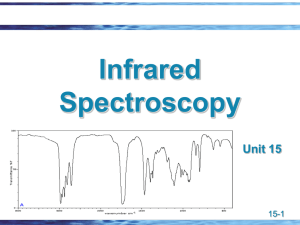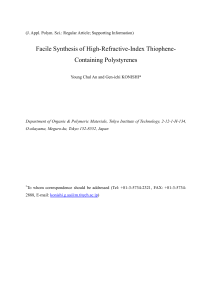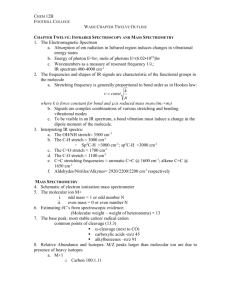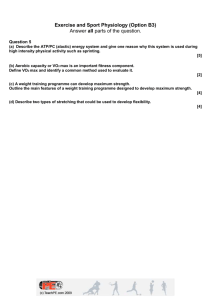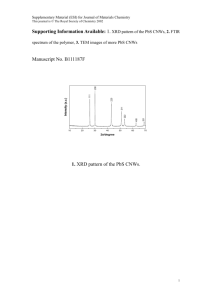Organic Chemistry
advertisement
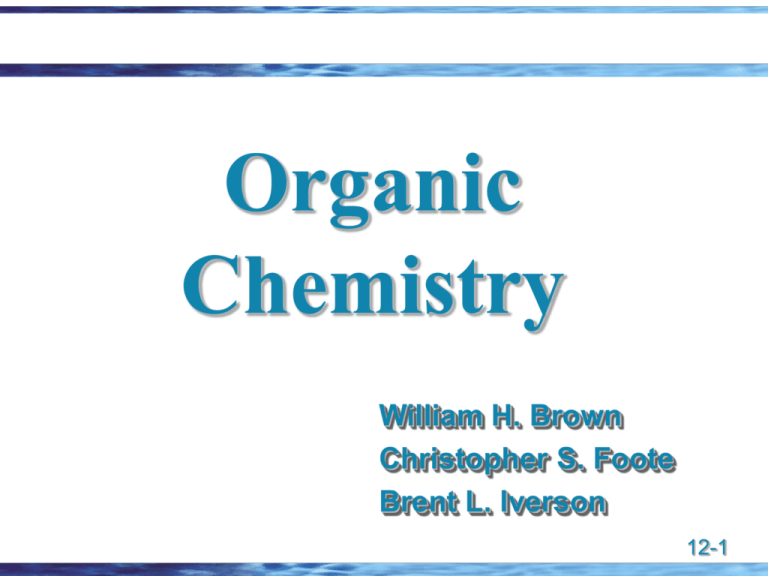
Organic Chemistry William H. Brown Christopher S. Foote Brent L. Iverson 12-1 Infrared Spectroscopy Chapter 12 12-2 Electromagnetic Radiation Electromagnetic radiation: light and other forms of radiant energy Wavelength (): the distance between consecutive peaks on a wave Frequency (): the number of full cycles of a wave that pass a given point in a second Hertz (Hz): the unit in which radiation frequency is reported; s-1 (read “per second”) 12-3 Electromagnetic Radiation Common units used to express wavelength Unit Meter (m) Millimeter (mm) Micrometer (m) Nanometer (nm) Angstrom (Å) Relation to Meter ---1 mm = 10-3 m 1 m = 10-6 m 1 nm = 10-9 m 1 Å = 10-10 m 12-4 Molecular Spectroscopy Molecular spectroscopy: the study of which frequencies of electromagnetic radiation are absorbed or emitted by a particular substance and the correlation of these frequencies with details of molecular structure • we study three types of molecular spectroscopy Absorption of Region of the Electromagnetic Electromagnetic Type of Radiation Results Spectrum Spectroscopy in Transition Between Radio fequency Nuclear magnetic Nuclear spin states resonance Infrared Vibrational energy levels Infrared Ultravioletvisible Ultravioletvisible Electronic energy levels 12-5 Infrared Spectroscopy vibrational IR extends from 2.5 x 10-6 m (2.5 m) to 2.5 x 10-5 m (25 m) The • the frequency of IR radiation is commonly expressed in wavenumbers - : the number of waves per centimeter, • wavenumber() with units cm-1 (read reciprocal centimeters) • expressed in wavenumbers, the vibrational IR extends from 4000 cm-1 to 400 cm -1 -2 -1 10 m•cm = = 4000 cm-1 2.5 x 10-6 m = 10-2 m•cm -1 2.5 x 10-5 m = 400 cm-1 12-6 Infrared Spectroscopy IR spectrum of 3-methyl-2-butanone 12-7 Molecular Vibrations • atoms joined by covalent bonds undergo continual vibrations relative to each other • the energies associated with these vibrations are quantized; within a molecule, only specific vibrational energy levels are allowed • the energies associated with transitions between vibrational energy levels correspond to frequencies in the infrared region, 4000 to 400 cm-1 12-8 Molecular Vibrations For a molecule to absorb IR radiation • the bond undergoing vibration must be polar and • its vibration must cause a periodic change in the bond dipole moment Covalent bonds which do not meet these criteria are said to be IR inactive • the C-C double and triple bonds of symmetrically substituted alkenes and alkynes, for example, are IR inactive because they are not polar bonds H3 C CH3 C C H3 C CH3 H3 C- C C- CH3 2,3-Dimethyl-2-butene 2-Butyne 12-9 Molecular Vibrations For a nonlinear molecule containing n atoms, there are 3n - 6 allowed fundamental vibrations For even a relatively small molecule, a large number of vibrational energy levels exist and patterns of IR absorption can be very complex The simplest vibrational motions are bending and stretching 12-10 Molecular vibrations Fundamental stretching and bending vibrations for a methylene group 12-11 Molecular Vibrations Consider two covalently bonded atoms as two vibrating masses connected by a spring • the total energy is proportional to the frequency of vibration • the frequency of a stretching vibration is given by an equation derived from Hooke’s law for a vibrating spring = 4.12 K K = a force constant, which is a measure of the bonds’ strength; force constants for single, double, and triple bonds are approximately 5, 10, and 15 x 105 dynes/cm = reduced mass of the two atoms, (m1m2)/(m1 + m2), 12-12 where m is the mass of the atoms in grams Molecular Vibrations = 4.12 K From this equation, we see that the position of a stretching vibration • is proportional to the strength of the vibrating bond • is inversely proportional the masses of the atoms connected by the bond The intensity of absorption depends primarily on the polarity of the vibrating bond 12-13 Correlation Tables Table 12.4 Characteristic IR absorptions for the types of bonds and functional groups we deal with most often Bond O-H N-H C-H C=C C=O C-O Stretching Frequency (cm-1) Intensity 3200-3650 weak to strong medium 3100-3550 2700-3300 weak to medium 1600-1680 weak to medium 1630-1820 strong 1000-1250 strong 12-14 Hydrocarbons-Table 12.5 Hydrocarbon Alkane C-H CH 3 C-C Alkene C-H C=C Alkyne C-H C C Arene C-H C=C C-H Vibration Frequency (cm-1 ) Intensity Stretching 2850 - 3000 Medium 1450-1475 Medium Bending 1375 and 1450 Weak to medium Bending (Not useful for interpretation - too many bands Stretching Stretching 3000 - 3100 1600 - 1680 Weak to medium Weak to medium Stretching Stretching 3300 2100-2250 Medium to strong Weak Stretching Stretching Bending 3030 1450-1600 690-900 Weak to medium Medium Strong 12-15 Alkanes IR spectrum of decane (Fig 12.4) 12-16 Alkenes IR spectrum of cyclohexene (Fig 12.5) 12-17 Alkynes IR spectrum of 1-octyne (Fig 12.6) 12-18 Aromatics IR spectrum of toluene (Fig 12.7) 12-19 Alcohols Bond -1 Frequency, cm Intensity O-H (free) 3600-3650 Weak O-H (H bonded) C-O 3200 - 3500 1000 - 1250 Medium, broad Medium • IR spectrum of 1-hexanol (Fig 12.8) 12-20 Ethers IR spectrum of dibutyl ether (Fig 12.9) 12-21 Ethers IR spectrum of anisole (Fig 12.10) 12-22 Amines IR spectrum of 1-butanamine (Fig 12.11) 12-23 IR of Molecules with C=O Groups Carbonyl Group Vibration Frequency (cm-1 ) Intensity O RCR' Ketones C=O Stretching 1630-1820 Strong O RCH Aldehydes C=O C-H Stretching Stretching 1630-1820 2720 Strong Weak Carboxylic acids C=O Stretching O H Stretching 1700-1725 2500-3300 Strong Strong (broad) O RCOH 12-24 IR of Molecules with C=O Groups O RCNH2 Amides C=O Stretching 1630-1680 N H Stretching 3200, 3400 (1° amides have two N-H stretches) (2° amides have one N-H stretch) O RCOR' Carboxylic esters C=O Stretching sp2 C O Stretching 3 sp C O O O RCOCR RC N Stretching Strong Medium 1735-1800 1200-1250 Strong Strong 1000-1100 Strong Strong Medium Acid anhydrides C=O Stretching C O Stretching 1740-1760 and 1800-1850 900-1300 Nitriles CN Stretching 2200-2250 Strong 12-25 Aldehydes and Ketones IR spectrum of menthone (Fig 12.12) 12-26 Carbonyl groups The position of C=O stretching vibration is sensitive to its molecular environment • as ring size decreases and angle strain increases, absorption shifts to a higher frequency O O O O 1715 cm-1 1745 cm-1 1780 cm-1 1850 cm-1 • conjugation shifts the C=O absorption to lower frequency O O O H -1 1717 cm -1 1690 cm -1 1700 cm 12-27 Carboxylic acids IR spectrum of pentanoic acid (Fig 12.13) 12-28 Esters IR of ethyl butanoate (Fig 12.14) 12-29 Infrared Spectroscopy End Chapter 12 12-30
